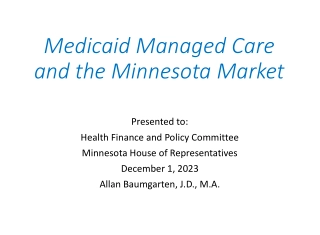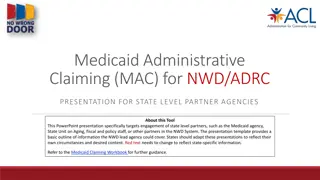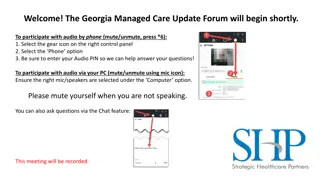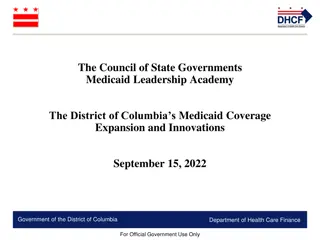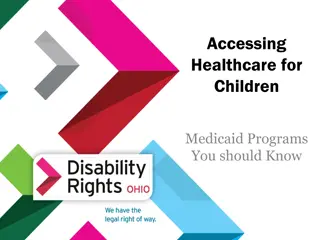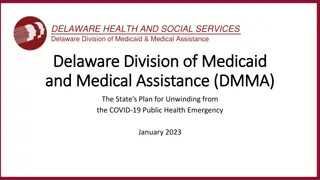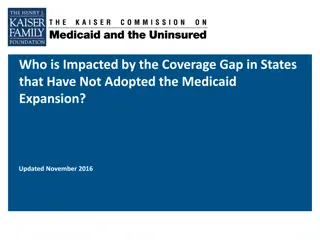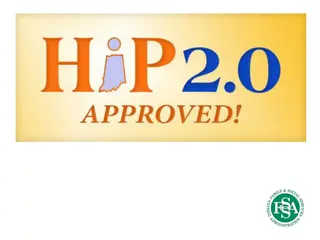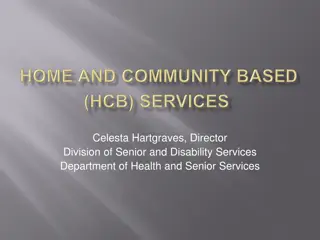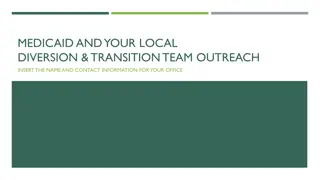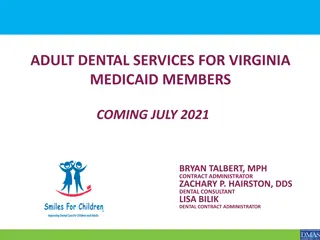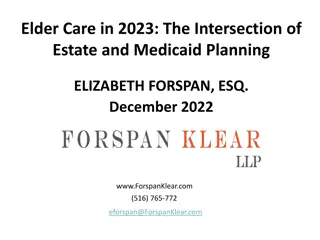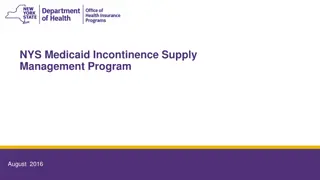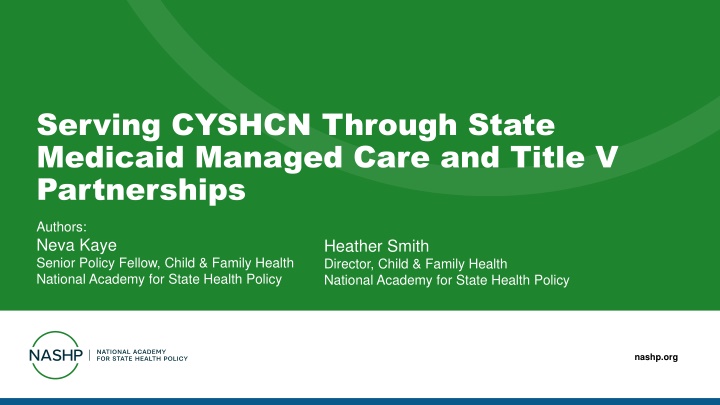
State Medicaid Managed Care for Children with Special Health Care Needs
Explore the collaboration between State Title V programs and Medicaid Managed Care to enhance services for children with special health care needs. Discover the various entities involved, payment models, and populations served under child-only managed care programs through insightful research and analysis by Neva Kaye and Heather Smith from the National Academy for State Health Policy.
Download Presentation

Please find below an Image/Link to download the presentation.
The content on the website is provided AS IS for your information and personal use only. It may not be sold, licensed, or shared on other websites without obtaining consent from the author. If you encounter any issues during the download, it is possible that the publisher has removed the file from their server.
You are allowed to download the files provided on this website for personal or commercial use, subject to the condition that they are used lawfully. All files are the property of their respective owners.
The content on the website is provided AS IS for your information and personal use only. It may not be sold, licensed, or shared on other websites without obtaining consent from the author.
E N D
Presentation Transcript
Serving CYSHCN Through State Medicaid Managed Care and Title V Partnerships Authors: Neva Kaye Senior Policy Fellow, Child & Family Health National Academy for State Health Policy Heather Smith Director, Child & Family Health National Academy for State Health Policy nashp.org nashp.org
Table of Contents 1. Medicaid Managed Care (MMC) Overview 2. Avenues for State Title V/Medicaid Collaboration 3. Goals of State Title V/Medicaid Collaboration 2 nashp.org
Medicaid Managed Care Overview nashp.org
Medicaid Managed Care Entities Managed Care Organization (MCO) Delivers comprehensive services including medical and, often, behavioral health care Assumes financial risk for delivery of services Most states pay MCOs a per member per month (PMPM) payment for contracted services (i.e., capitation) Primary Care Case Management (PCCM) Primary care providers contract with the state to provide care coordination/case management services Some states also contract with PCCM entities (PCCM- E) to provide additional care coordination support Most states pay PCCM providers a per member month fee + fee-for-service for services delivered. PCCM-E are more likely to be paid PMPM. Prepaid Ambulatory Health Plan (PAHP) Does not have a comprehensive risk contract, meaning: Delivers less than comprehensive services such as solely behavioral health services, or Not at financial risk for delivery of comprehensive services Not responsible for delivery of inpatient hospital or institutional services States use capitation, cost-based, and other payment models States also use a fee-for-service (FFS) payment delivery system. Under a FFS system, states contract with and pay providers directly for covered services provided to Medicaid beneficiaries. Prepaid Inpatient Health Plan (PIHP) Does not have a comprehensive risk contract Includes associated inpatient hospital or institutional services, such as inpatient behavioral health services States use capitation, cost-based, and other payment models 4 nashp.org
States Delivering Services to Children through Medicaid Managed Care (MMC), 2020 5 nashp.org Source: State Medicaid Managed Care Program Design for Children and Youth with Special Health Care Needs
Populations Served by Child-only Managed Care Programs, 2023 Population Served Children in foster care and/or adoption assistance State AZ, FL, IL, MA*, TX, WA, WV Children with complex behavioral health needs Children with disabilities Children in foster care, adoption assistance, and/or juvenile justice system Children with special health care needs who meet clinical criteria+ * Serves only a defined subgroup of the population ^ Provides a limited benefit package (PIHP/PAHP) +Clinical criteria are specified in Florida rule LA*^, OH*^, WI*, WY*^ DC*, TX, TN* GA, KY FL* nashp.org Source: How States Promote the Provision of Quality Care to CYSHCN Enrolled in Medicaid Managed Care: Findings from a 50-State Analysis 6
Supporting CYSHCN Through Managed Care, 2023 States enroll CYSHCN into MMC to enhance care coordination, control health care costs, and improve health care quality and outcomes. Definition Quality CYSHCN AZ, CA, DC, DE, FL, GA, IA, IL, IN, KS, KY, MA, MD, MI, MN, NC, NH, NJ, NV, NY, RI, TN, UT, VA, WA, WI CA, DC, FL, IN, MI, NC, RI, TX, UT, WI 18 states have language requiring some level of coordination/partnership with the state Title V Agency in at least one contract. 35 states have a relevant definition in at least one contract. 26 define CYSHCN; 10 define members with special health care needs (MSHCN), Florida does both in separate contracts. MSHCN AL, CO, FL, HI, LA, NE, OH, OR, PA, TX AR, AZ, CO, DC, DE, GA, IA, IL, IN, KS, KY, LA, MA, MD, MN, MO, MS, NC, NH, NM, NV, OH, OR, PA, SC, TN, VA, VT, WA, WI, WV 37 states have a relevant provision addressing quality in at least one contract. 10 call out CYSHCN; 31 call out MSHCN; 4 do both in separate contracts. nashp.org Source: Medicaid Managed Care for Children and Youth with Special Health Care Needs: 50-State Scan 7
Medicaid Managed Care Organizations Medicaid agencies contract with MCOs that deliver a defined package of services Provide comprehensive benefits MCOs contractually required to meet performance standards for quality, care coordination, provider network and other aspects of service delivery Develop provider networks Provide care coordination MCOs contract with and pay providers directly Medicaid MCOs Medicaid agencies pay MCOs via a per member per month capitation payment Many states also establish financial incentives for MCO performance Measure performance and improve quality Support access to transportation services 8 nashp.org
Key Steps in the Medicaid Managed Care Procurement Process Policy Papers/Briefings Bidding Process RFP Release Contract Selection Medicaid agencies detail MMC program priorities, often through the release of policy papers. MCOs enter a formal bidding period where they submit their developed proposals to the state Medicaid agency. The RFP is released and reviewed by MCOs interested in bidding for the contract. The state announces its intent to contract with successful bidders and finalizes payment rates. 2 1 3 5 7 6 4 RFP Development Proposal Review Planning Proposal Review The state develops a request for proposal (RFP) reflecting key elements of the MMC program. The panel reviews MCO proposals, utilizing specified evaluation tools that rank programmatic responses and MCO price bids. Medicaid agencies conduct independent review of MCO proposals, including establishing review panels. 9 nashp.org Source: Strengthening Title V Medicaid Managed Care Collaborations to Improve Care for CYSHCN
Avenues for Title V and Medicaid Collaboration nashp.org
MCE Procurement Process Align program goals and services delivered to CYSHCN throughout a state Offer to meet with Medicaid staff to discuss procurement plans during formative stage Review and comment on policy papers, requests for proposal, and contracts Serve on review committees 11 nashp.org
MMC Quality Improvement Ensure that Ensure that quality standards, performance measures, and quality improvement efforts reflect the needs of CYSHCN Serve on MMC quality advisory committees Review and comment on state quality strategy Identify key performance measures to incorporate into quality strategy and contract 12 nashp.org
Data Sharing Across Agencies Identify gaps in care and duplication of services for CYSHCN and align resources Establish data sharing agreements that support cross-system coordination on health, social, and community-based services Align Title V and MMC shared plans of care for CYSHCN Develop Title V and MMC joint messaging for families of CYSHCN Engage in care conferences for those served by both Title V and MMC 13 nashp.org Source: Strengthening Title V Medicaid Managed Care Collaborations to Improve Care for CYSHCN
State and Community Needs Assessments Develop a comprehensive understanding of CYSHCN needs across a state Invite and support MMC participation in the five-year maternal and child health needs assessment process Establish regular strategic planning discussions with MCOs related to service needs, coordination activities, and partnership opportunities Support consumer engagement and participation in community needs assessments conducted by MCOs 14 nashp.org Source: Strengthening Title V Medicaid Managed Care Collaborations to Improve Care for CYSHCN
Interagency Agreement Define the Title V role in MMC procurement and operations Ensure that the IAA addresses: Payment for Title V-supported providers, including how MCE membership will impact payment Specifies how the Title V agency will be involved in MCE procurement and quality improvement efforts Establish a process for bringing information about how MCE enrollment is affecting CYSHCN to the Medicaid agency and to work together to develop solutions to identified problems. 15 nashp.org
Goals for Title V and Medicaid Collaboration nashp.org
Using the Information in this Section This section offers examples of how states have used available policy avenues to address goals that are important to improving the care delivered to CYSHCN Title V programs could: Encourage their Medicaid agency to adopt similar strategies Supply input and data for Medicaid and MCE planning and evaluation efforts Ensure that these initiatives, which are sometimes designed for broader populations, consider and address the needs of CYSHCN and their families 17 nashp.org
Advance Health Equity Alignment between State Title V agencies and MMC program goals to improve care for CYSHCN of color and their families can help to create a coordinated state response Strategies for State Title V and Medicaid Programs to Promote Health Equity for Children of Color with Special Health Care Need Strategies for State Title V and Medicaid Programs to Promote Health Equity for Children of Color with Special Health Care Need Louisiana established health equity as a main objective of their 2021 MMC procurement. Among other requirements, this state required MCOs to demonstrate how they planned to use data to address inequities and required MCOs to implement staffing and organizational strategies to promote equity. improve health equity screening for health related social needs (HRSN) Oregon requires its MCOs (referred to as Coordinated Care Organizations or CCOs) to report performance on a set of measures and offers incentive payments for performance on some measures. In recent years those measures have included a measure designed to improve health equity and a measure designed to address the social determinants of health (SDOH) by encouraging screening for health related social needs (HRSN). Oregon has also added contract requirements and implemented financial incentives to meet enrollees HRSN. added contract requirements and implemented financial incentives See Strategies for State Title V and Medicaid Programs to Promote Health Equity for Children of Color with Special Health Care Need for more examples and strategies. 18 nashp.org
Strengthen Care Coordination in Medicaid and State Title V Agencies Collaboration between Title V and MMC care coordination efforts can reduce duplication of services and help families receive more targeted assistance. Strengthening Title V - Medicaid Managed Care Collaborations to Improve Care for CYSHCN Colorado Title V staff developed the Colorado Care Coordination Collaborative, which focused on increasing efficiency and reducing duplication of care coordination services for CYSHCN provided through MMC programs, the state EPSDT benefit outreach program, and Title V. The lessons learned from this collaborative helped shaped the Medicaid agency s Accountable Care Collaborative Program and MMC delivery system as well as the state s medical home action plan. New Mexico s Title V program worked with the Medicaid MCOs Medical Directors s to develop a consistent set of Patient Centered Medical Home (PCMH) standards. This state s Title V program also shares its expertise in delivering care coordination services and supports for CYSHCN to the Medicaid program s quality standards for MCOs, supporting the transition of CYSHCN to sustainable and coordinated medical homes. See Strengthening Title V - Medicaid Managed Care Collaborations to Improve Care for CYSHCN for more examples and strategies. nashp.org 19
Increase Family Engagement in Program Operations Title V s strong relationships with families can provide a valuable resource to Medicaid agencies as they incorporate family experiences and input into their MMC programs. Strengthening Title V - Medicaid Managed Care Collaborations to Improve Care for CYSHCN member advisory board Delaware s Title V program partners with Family Voices to convene monthly calls to provide a non-adversarial venue for family members to ask questions or discuss an issue about the care provided to their child by MCOs and other key partners. Delaware s MCH program reports that, as a result, individual problems are solved, many families get a better understanding the system and policymakers hear how a family is impacted by the rules and regulations. New Mexico s contract requires MCOs to establish a member advisory board with members representing all Centennial Care [the name of the managed care program] populations, family members and Providers. The CONTRACTOR shall have an equitable representation of its Members in terms of race, gender, special populations and New Mexico s geographic areas. The contract also specifies the role of the board in program operations. See Strengthening Title V - Medicaid Managed Care Collaborations to Improve Care for CYSHCN for more examples and strategies. 20 nashp.org
Provide for Ongoing Collaboration MMC programs will continue to evolve and new opportunities and issues will emerge. Title V and Medicaid programs could both benefit from establishing ongoing avenues for collaboration at the agency and MCO levels. Oregon s Interagency Agreement West Virginia s contract requires MCOs Oregon s Interagency Agreement (IAA) details the specific topics on which the Title V and Medicaid agencies will collaborate, including on providing training to MCOs, quality improvement activities, and recruiting families to participate in MCOs consumer advisory councils. It also specifies a process for the agencies to work together and to regularly review and update the IAA. consumer advisory councils West Virginia s contract requires MCOs to establish memorandums of understanding (MOUs) with the state s office of child and family health. The MOU commits the two entities to appropriate collaboration on quality improvement activities, education, and other initiatives targeted at improving the care and health outcomes for children with special health care needs. It also details how they will coordinate the care coordination that both provide as well as how they will share data to improve service delivery and outcomes. 21 nashp.org
Selected Resources Strengthening Title V - Medicaid Managed Care Collaborations to Improve Care for CYSHCN (NASHP, 2021) Strategies for State Title V and Medicaid Programs to Promote Health Equity for Children of Color with Special Health Care Needs (NASHP, 2021) Managed Care (Centers for Medicare & Medicaid Services (CMS), 2022) Medicaid Reimbursement of Title V Care Coordination Services (NASHP, 2022) Medicaid s Transportation Benefit and Children and Youth with Special Health Care Needs (NASHP, 2022) State Quality Strategies (CMS, Downloaded 2023) More information on state maternal and child health policy resources can be found at NASHP.org. 22 nashp.org

